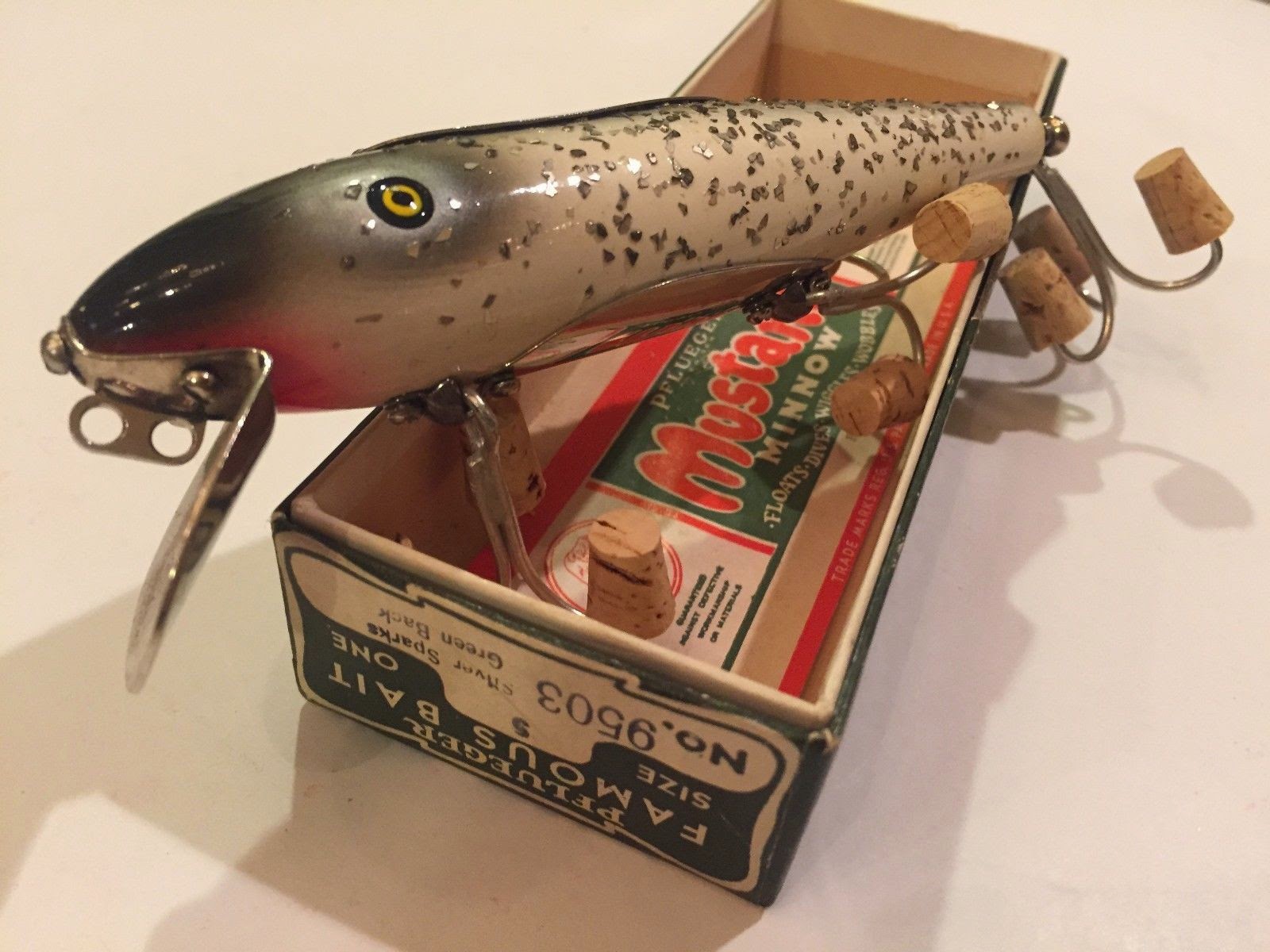Just got this in today and wanted to share it with you.
First, a brief history of the Pflueger Company.
 Founded in 1881 in Akron, Ohio, E. F. Pflueger’s Enterprise Manufacturing Company was not the first company to manufacture a fishing reel—that
honor goes to the Meek Brothers, whose Kentucky reels predate 1840. But
Pflueger was the first major commercial tackle company—its 1900
catalog, produced two years before James Heddon hung out his shingle to sell handmade wooden fishing lures, featured 126 pages of "Fish Bait and Anglers Specialties."
Founded in 1881 in Akron, Ohio, E. F. Pflueger’s Enterprise Manufacturing Company was not the first company to manufacture a fishing reel—that
honor goes to the Meek Brothers, whose Kentucky reels predate 1840. But
Pflueger was the first major commercial tackle company—its 1900
catalog, produced two years before James Heddon hung out his shingle to sell handmade wooden fishing lures, featured 126 pages of "Fish Bait and Anglers Specialties." In the 1890s, Pflueger produced rubber decoys,
the rubber Muskallonge Minnow (it had three single hooks and metal
fins), and, in 1899, the Trory Minnow, which had three treble hooks,
propellers at its head and tail, and yellow glass eyes.
In the 1890s, Pflueger produced rubber decoys,
the rubber Muskallonge Minnow (it had three single hooks and metal
fins), and, in 1899, the Trory Minnow, which had three treble hooks,
propellers at its head and tail, and yellow glass eyes.Throughout the early part of the 20th century, Pflueger produced numerous minnows and bugs, some weighted, some designed to float. But the competition from Heddon and others proved too much for the company. Fortunately, lures were not its only source of revenue. Indeed, Pflueger reels would keep the company independent until well after the middle of the century.
 The product that secured Pflueger’s reputation for reliability and
dependable action while casting was the Baitcasting Reel, introduced in
1916. The brand for this new line of fishing reels
was Four Brothers, who were E. A., Joseph, George, and Charles. Models
included the Delite fly reel, in 40-, 60-, 80-, and 100-yard sizes. The
reels’ plates were made of hard rubber and covered with either polished
nickel or satin gun metal. Also available in that introductory year was a
double-multiplying casting reel called the Medina, so named for the
county west of Akron.
The product that secured Pflueger’s reputation for reliability and
dependable action while casting was the Baitcasting Reel, introduced in
1916. The brand for this new line of fishing reels
was Four Brothers, who were E. A., Joseph, George, and Charles. Models
included the Delite fly reel, in 40-, 60-, 80-, and 100-yard sizes. The
reels’ plates were made of hard rubber and covered with either polished
nickel or satin gun metal. Also available in that introductory year was a
double-multiplying casting reel called the Medina, so named for the
county west of Akron. By 1924, Pflueger had largely dropped the Four Brothers name in favor of
the model names themselves. The Regal, Elinor, and Pastime reels were
still marketed as Four Brothers reels, but the Delite reel was now sold
on its own. So were the Eclipse and Mohawk reels, which were salt-water
models. Two other smaller salt-water reels, Sumco and Beacon, were
introduced in 1927, and the Castwell came along in 1931 (it was
introduced as the Comrade but that dull name was quickly changed).
By 1924, Pflueger had largely dropped the Four Brothers name in favor of
the model names themselves. The Regal, Elinor, and Pastime reels were
still marketed as Four Brothers reels, but the Delite reel was now sold
on its own. So were the Eclipse and Mohawk reels, which were salt-water
models. Two other smaller salt-water reels, Sumco and Beacon, were
introduced in 1927, and the Castwell came along in 1931 (it was
introduced as the Comrade but that dull name was quickly changed).Other antique and vintage Pflueger fishing reels sought by collectors include the Skilcast ("Blister Proof" is the guarantee on the side of the box), the Supreme, and an Orvis-like fly reel called Taxie. In the 1930s, Pflueger all but discontinued its line of lures, which is what helps make those lures so rare today. In 1954, Pflueger introduced its first spinning reel, and in 1966 the company was sold to Shakespeare. Today, reels, rods, and combos bearing the Pflueger name continue to be manufactured in South Carolina.
Courtesy Collectors Weekly
The No. 4128 "Captain" is a 4 3/4" diameter spool, single action trolling reel with thumb stop. This one is full of braided copper line. These would have been mounted on a heavy duty, boat-rod style fishing pole. Montague was a very popular rod for this use. It would be used for Lake Trout or Salmon on the Great Lakes. I would grade condition as Fine on this reel. It includes original, correct box and can be purchased here






No comments:
Post a Comment